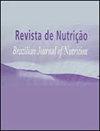Potential for healthy eating in a Brazilian public university food environment
IF 0.5
4区 医学
Q4 NUTRITION & DIETETICS
Revista De Nutricao-brazilian Journal of Nutrition
Pub Date : 2023-05-19
DOI:10.1590/1678-9865202336e210180
引用次数: 0
Abstract
ABSTRACT Objective To identify the food environment healthy eating potential in the authorized food services on the campus of a Brazilian university. Methods This is an observational study carried out between March and April 2014 on a campus of a public university in Rio de Janeiro, Brazil. The elements of the food environment were evaluated using an audit instrument, containing 86 questions: availability (amount of food services and types of food offered), convenience (days and hours of operation), incentives and barriers to healthy eating (nutrition information, payment strategies and food advertisements). Preparations based on whole grains and fresh or minimally processed products were considered healthy foods; and, preparations with high caloric density, sugar-sweetened beverages, sweets, desserts, cookies, and savory snacks were considered unhealthy food. The questionnaire allowed us to calculate a score for each service, which could range from 0 to 36 points, and indicates the potential for promoting healthy eating in the establishment, with higher scores indicating a greater presence of elements that contribute to healthy eating. The different types of food service facilities were compared based on the scores (p<0.05 for statistical significance). Results Among the establishments evaluated, 24% were snack bars/cafeterias, 26%, restaurants, and 50% offered mixed services. Healthy food items were scarcely available in the establishments (fruits: 24%; vegetables: 20%; brown rice: 15%); while added-sugar beverages (98%), sweets and treats (76%) were widely offered. There was a higher frequency of advertising encouraging consumption of unhealthy items than that aimed at healthy foods (44% vs 30%). In general, the score was 13,2 points (SD=3.3) and the mean score for snack bars/cafeterias (9.3 points) was lower (p<0,05) than that of restaurants and mixed establishments (14,4 points). Conclusion On the campus assessed, the food environment had limited potential for healthy eating, since elements that did not favor healthy food choices were more frequent.巴西公立大学饮食环境中健康饮食的潜力
【摘要】目的了解巴西某大学校园授权餐饮服务机构的食品环境健康饮食潜力。方法本研究于2014年3月至4月在巴西里约热内卢一所公立大学的校园内进行。使用一种审计工具对食品环境要素进行了评估,其中包含86个问题:可得性(食品服务的数量和提供的食品类型)、便利性(营业天数和时间)、健康饮食的激励和障碍(营养信息、支付策略和食品广告)。以全谷物和新鲜或最低限度加工产品为基础的制剂被认为是健康食品;高热量的食品、含糖饮料、糖果、甜点、饼干和咸味小吃被认为是不健康的食品。通过问卷,我们可以计算出每项服务的得分,得分范围从0到36分,这表明该机构在促进健康饮食方面的潜力,得分越高,表明有助于健康饮食的因素越多。对不同类型餐饮服务设施的得分进行比较(p<0.05,有统计学意义)。结果在评估的场所中,24%为小吃店/自助餐厅,26%为餐厅,50%为混合服务。这些场所几乎没有健康食品(水果:24%;蔬菜:20%;糙米:15%);虽然添加糖饮料(98%),但糖果和点心(76%)被广泛提供。鼓励消费不健康食品的广告频率高于健康食品的广告频率(44%对30%)。总体得分为13.2分(SD=3.3),小吃店/自助餐厅的平均得分(9.3分)低于餐馆和混合场所的平均得分(14.4分)(p< 0.05)。在被评估的校园中,食品环境对健康饮食的潜力有限,因为不利于健康食品选择的因素更为频繁。
本文章由计算机程序翻译,如有差异,请以英文原文为准。
求助全文
约1分钟内获得全文
求助全文
来源期刊
CiteScore
1.20
自引率
12.50%
发文量
24
审稿时长
6-12 weeks
期刊介绍:
Revista de Nutrição is former Revista de Nutrição da Puccamp, founded in 1988. It is a bimonthly publication every four months and it is of responsibility of the Centro de Ciências da Vida, da Pontifícia Universidade Católica de Campinas . It publishes articles that contribute to the study of Nutrition in its many sub-areas and interfaces; and is open to contributions of the national and international scientific communities.

 求助内容:
求助内容: 应助结果提醒方式:
应助结果提醒方式:


